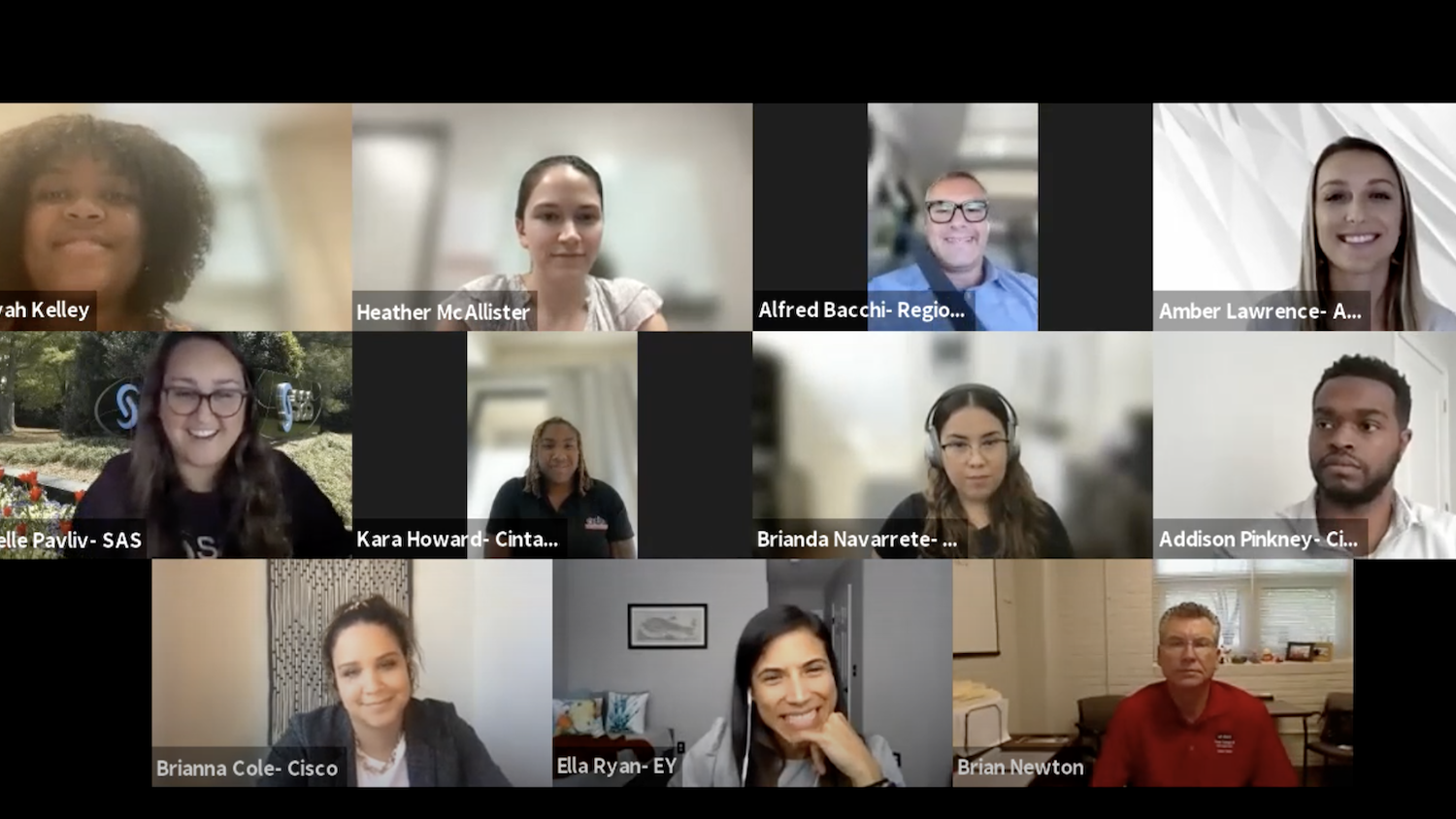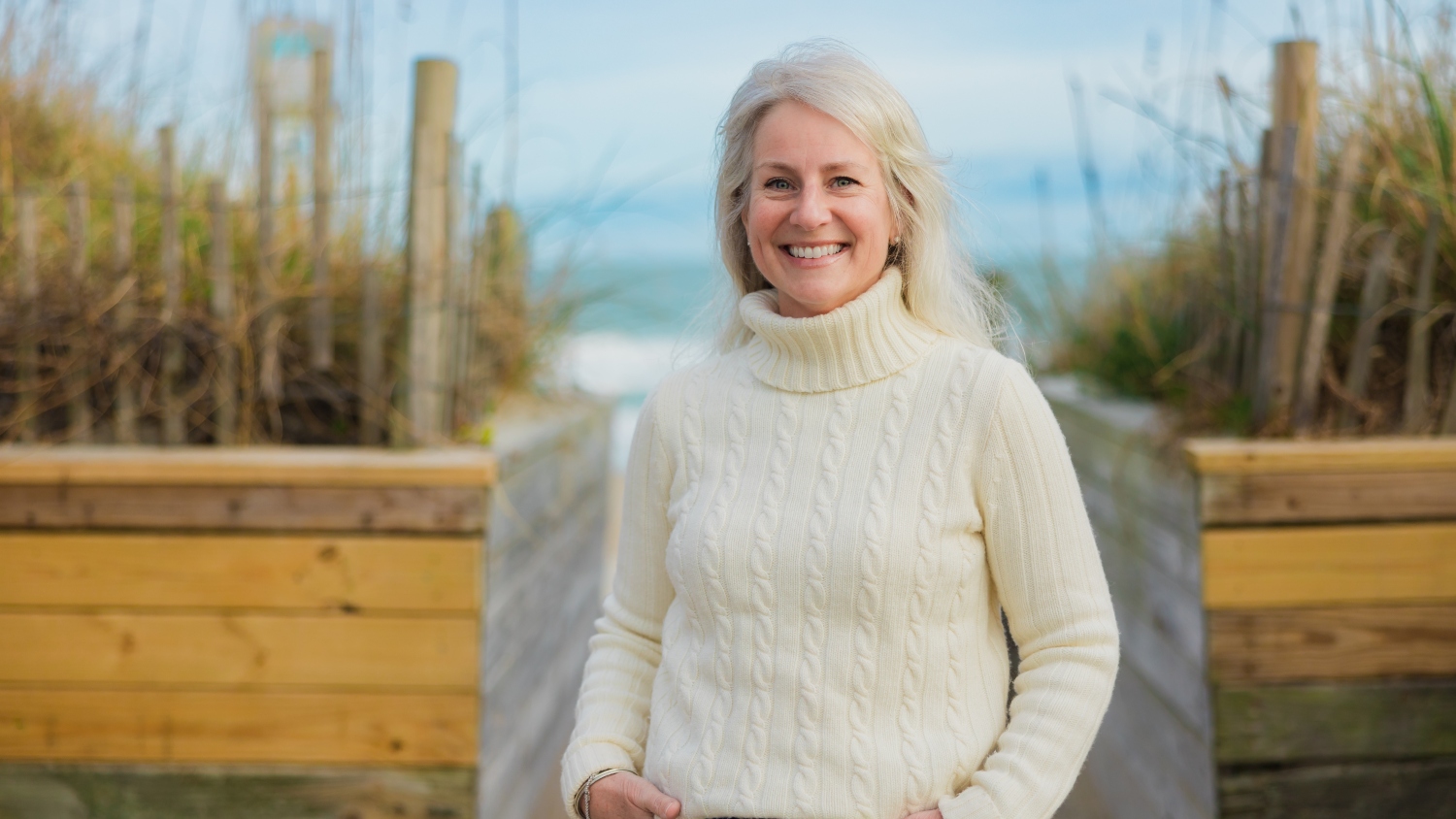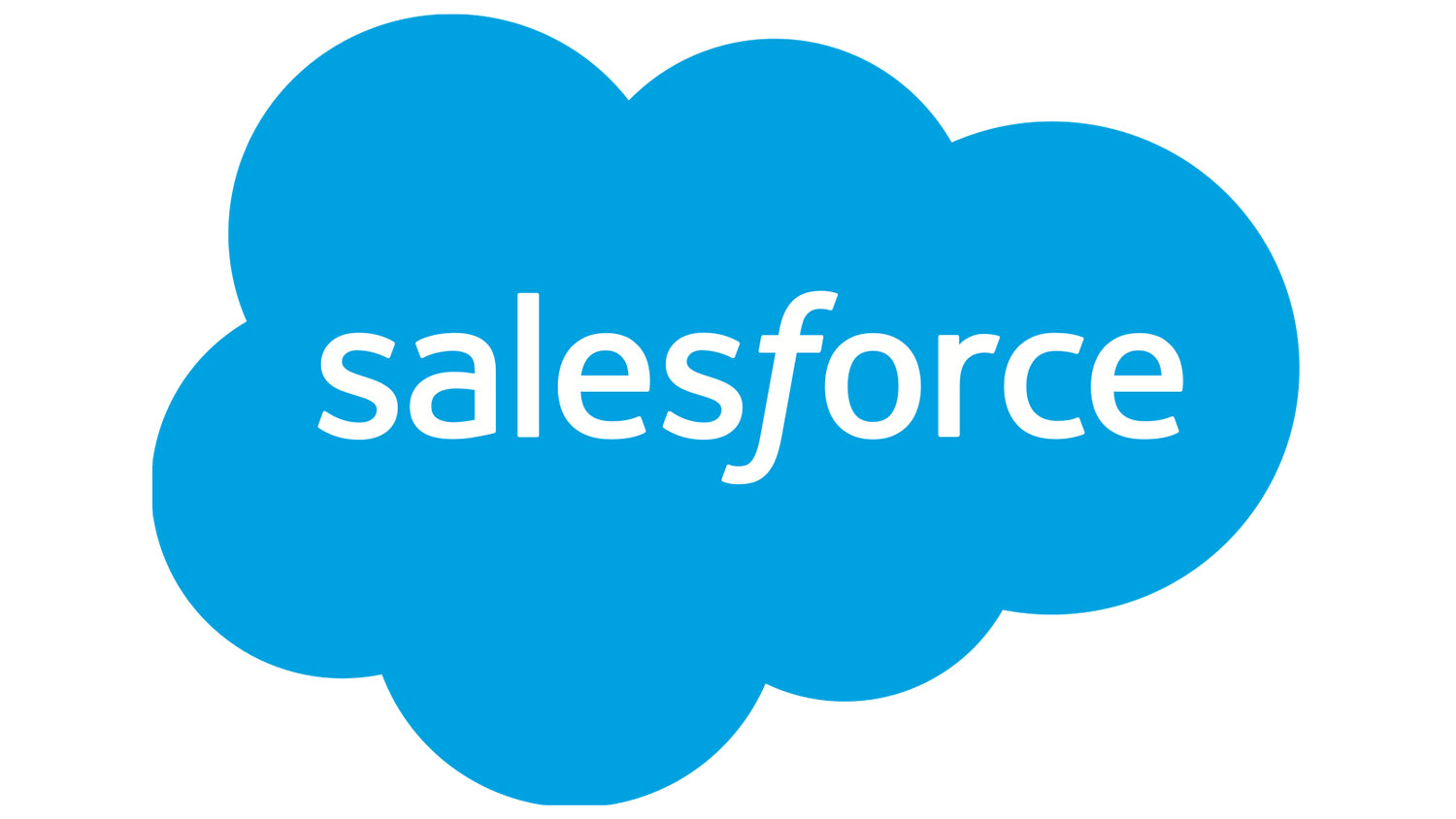Business and Industry Leaders Discuss Diversity, Equity and Inclusion in the Workplace

By Lea Hart
The Poole College of Management’s Fall 2021 Career Weeks featured an Inclusive Leaders Conversation on Wednesday, Sept. 29.
Company leaders from organizations such as ABB, Cintas, Cisco, EY, Regions Bank and SAS discussed best practices in diversity, equity and inclusion (DEI) in the workplace.
The list of company leaders included:
- Glenda Bowman, senior tax manager, EY
- Cristal Graves, diversity talent acquisition lead, SAS
- Danielle Pavliv, chief diversity officer, SAS
- Alfred Bacchi, managing director, Regions Bank
- Kara Howard, campus talent acquisition manager, Cintas
- Kyra Carter, Cintas
- Brianna Cole, global inclusion and collaboration program manager, Cisco
- Sabrina Gonzalez, global cross industries marketing specialist, Cisco
- Brianna Navarrete, Cisco
- Addison Pinkney, Cisco
- Amber Lawrence, talent ambassador, ABB
What are best practices in DEI in the workplace today? How are pay disparities being addressed among minorities? How can companies continue to focus on DEI initiatives as the company grows?
The panelists weighed in on these and other questions.
Can you give us an overview of DEI practices at your company?
Bowman: We focus on three main pillars. First, internal talent and building business processes. We have internships specifically designed for underserved minorities. We also have mandatory anti-bias training, and frequent performance feedback to make sure employees of diverse backgrounds have the support they need to continue to progress in their careers. The second pillar centers around driving policy change, and the third pillar is focused on how we engage with our community and our clients. We invest financially through several volunteering programs and we support minority entrepreneurs.
Pavliv: We also have three pillars to our DEI strategy. The first centers around increasing representation across the entire workforce. This is not just about who we’re hiring but also about key leadership roles and management. We look at representation as well as promotion and attrition – why are people leaving. The second pillar is focused on inclusion and culture. We have 14,000 employees from 59 countries. We think about our inclusion strategy from a very multidimensional perspective. Part of that is employee inclusion groups. We have seven of those and they are a huge driver of our DEI efforts. The final pillar is community and education. As we think about increasing the diversity of our workforce, we are also thinking about how to increase diversity of the future workforce.
Cole: Cisco’s mission is to power an inclusive future for all, and that drives everything that we do. We center this around three pillars as well. The first, hiring, focuses on embedding fairness in every step of the interview process. The second pillar centers on development – how we develop our leaders and teams. The final pillar is engagement. We have employee resource organizations (ERO), groups with varying backgrounds and perspectives and lived experiences that we engage with. We embed inclusion into everything that we do.
Lawrence: ABB has tangible, actionable goals created by our global leaders in the DEI space. We’re working to make sure that, by 2030, these aren’t just goals but that we’re showing we’re putting it into action. We have 12 employee groups across various affinity groups that are open to allies as well. Around 3,000 of our employees in the U.S. are active in one of these groups. We have global initiatives as well. We do regular unconscious bias training, and host inclusive leadership workshops. We have a human rights campaign and a corporate equity index. At ABB, it’s about how we make sure everyone feels safe to show up to be who they are, to share their ideas, and know that they aren’t going to be put down or pushed aside, so we can be as collaborative and successful.
Bacchi: Our key approach in our business is shared value. Our mandate as a business is that everything we do must serve shareholders, associates, clients and the communities that we serve. That really comes through in how we approach DEI. We integrate DEI into our business – there is a Chief Diversity, Equity and Inclusion Officer, but really, it’s an employee-owned strategy. Since we focus on the regions and markets that we serve, we have 18 separate DEI networks, which align to the markets where we operate. We bring associates across groups, across business lines, and importantly, across axes of diversity. Rather than groups specific to issues, we try to work together as teams and address all of these issues holistically.
There are well-documented pay disparities that exist between majority status individuals and minority populations – how is your organization working to address these disparities?
Lawrence: I can speak to Early Talent Program specifically, because that’s what I’m involved in. At ABB, we believe you get paid for the job that you do. Experience is great, but you’re doing a job that requires a certain amount of work, no matter your background or years of experience, etc. For our early talent programs, pay is the same across the board; there is no variation and we make sure that it is fair.
Cole: We’re constantly looking at what we’re paying our employees and if there are gaps, we address them and fix them. We’re very proud to be one of the founding 28 signers of the White House Equal Pay Pledge, so we’re definitely a national leader in pay parity. Also, Cisco really values our culture of sponsorship. We foster programs that encourage that sponsorship across difference, because there’s a sponsorship gap as well.
Pavliv: We have a very standard pay rate process for student programs, based on their major and year in school. We ensure everyone is paid to do the job they’re hired to do. From there, we’re using our internships as a pipeline for full-time employment, so then everyone is starting from the same place. We have a global career framework at SAS as well. It has very clear pay bands and very clear pay progression that is available to employees. We conduct ongoing and very frequent pay audits to ensure that we are being proactive.
How is your company focused on continuing DEI objectives as you grow and add new hires? Do you feel that it becomes more challenging to maintain your standards as your company grows? Do you already have practices in place to mitigate this potential difficulty?
Bowman: I tell students, when you’re interviewing for a position, the company is also interviewing you. We want to make sure that you’re going to fit in with our culture. That’s one of the ways in which we ensure that, as we continue to grow, we maintain our culture, our focus on people, and can execute our strategy in diversity. The other way is in specific programs we have in place to ensure that we have leaders within each of our offices that are promoting and executing each of our strategies – not just our business strategies but also our diversity and inclusion strategies.
Lawrence: Culture has to be part of the interview process. No matter how big your company gets, that has to stay true. We have very specific questions that we’ve cultivated around our values so we can see if you align with our values. If not, it’s not going to be a good fit for either person – the company or the candidate.
Bacci: I looked at this question a little differently – as a challenge that we give ourselves to look at candidates and imagine what we can do to help them be successful, versus what they’re bringing to us. In banking, there are certain skills you need in finance and accounting but there are also skills that we can bring to you. The other part, once somebody joins, is that it’s really incumbent on all of us as a team to help each other be successful, and make sure we stick to our values as well.
Cole: We can’t just hire a bunch of people from non-traditional backgrounds and not have the resources to support them. A piece of that is the culture. We have a very people-first culture, making sure everyone feels welcome, heard and valued. The second piece is onboarding. We have specific cohorts for our interns as well as our early-in-careers. I’m personally a product of the Cisco Sales Associate Program. They put us through a few months of bootcamp where we could learn, play, and ask questions. I thought that was such a unique opportunity.
What DEI awareness do you like to see in a new hire? Are you going to do DEI training in your organization or expect them to bring that awareness with them?
Pavliv: What we look for, especially in students, is that curiosity. When I started at SAS, I was told we should be looking for passion, attitude and aptitude. That really resonated. Some of the best hires we’ve made are people that are really passionate. They have the aptitude, but they just have a great attitude and a willingness to learn. We don’t expect you to be an expert. We can train you, but what we can’t teach is curiosity, passion, attitude and aptitude.
Lawrence: I always say, I’m looking for the things we can’t teach you easily – character, curiosity, courage and collaboration. Are you a team player? Are you excited to come in to learn new things? Are you open-minded? Are you interested in collaborating? We also offer workshops once you’re hired, including diversity and inclusion training and workshops on topics like unconscious bias. So we look for people who are excited about coming in and being a part of the change that we’re creating now.
If you could add an additional bullet to your organization’s DEI objectives, what would it be? Or what do you see as the future of DEI and how should we as students prepare for it?
Pavliv: One area that’s kind of obvious but deserves more attention is around thought diversity. In a global organization, when we talk about thought diversity or diversity of lived experiences, that’s where I see the lightbulb goes off. Having the conversation about different ways of thinking based off life experiences opens up a lot more richness to the conversation around DEI. Not that other topics are not equally as important, but I do think that’s where you can get a lot of folks to dive deeper into the conversation.
Cole: The next pillar would maybe be empathy, though I don’t know exactly how this would work. One of the things we’re talking about is having empathy as our superpower. With Covid and everything going on with the world, we’re seeing everyone working from home. So the idea of leading with empathy when we’re having conversations, because we don’t know the full story. If we lead with empathy and curiosity when engaging with other people, I think that could really drive an incredible culture.
What do you believe is the outlook for DEI in firm and employee handbooks? Are the implications of Covid-19, Black Lives Matter and all of 2020 affecting the outlook for inclusion so far?
Bacchi: Because of Covid and everything we’ve seen in the economy and the job market, although there are a lot of people unemployed, there’s also a lot of job openings. It’s forcing companies to be more creative about hiring different candidates. You can’t hire people just based on diversity, but I think the economy is forcing the issue a bit right now. I do think you’ll start to see more of this across the board.
Bowman: To be a CPA, you have to have a certain number of accounting credit hours. We’ve recognized that some of our underserved students may not have the resources to get a Master’s degree. EY started offering fellowships to find alternatives to obtain those credit hours so that students can sit for the CPA exam without having to get that degree. I think companies are going to have to get creative.
Lawrence: Employee experience has always been important, but the last two years have changed everything. You have to listen to your employees and you have to support your employees. Whether that’s flexibility – we used to be a very old school company where you were in the office every day – companies have to be paying more and more attention to make sure they’re not only getting top talent but retaining it.
This post was originally published in Poole Thought Leadership.


